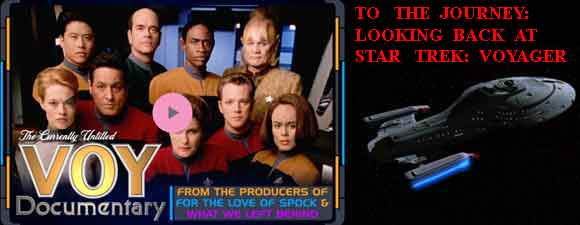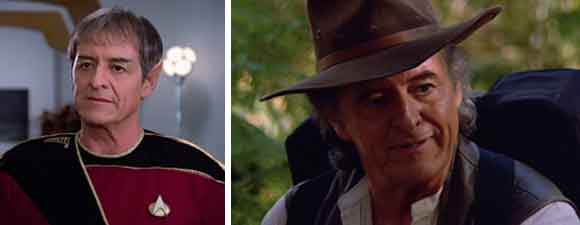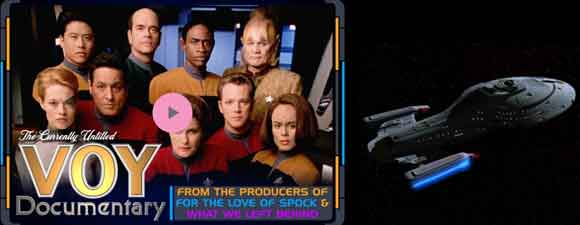Retro Review: The Thaw
7 min read
thethawbanner
When Torres and Kim enter a matrix linking several unconscious aliens, they discover that Fear holds the aliens mentally captive.
Plot Summary: Voyager discovers a planet that has endured a cataclysm from solar flares. When a recorded message greets the crew, a scan below the surface reveals several individuals trapped in stasis. The engineers are able to beam up all the hibernation pods, but two of the pods contain dead bodies and the rest are linked in a neural network that the Doctor believes might be lethal to the survivors if disrupted. Janeway decides to let Kim and Torres enter the network by putting them into the chambers previously occupied by the dead aliens. Once inside, they find themselves in a macabre circus ruled over by Fear, a menacing clown whom alien leader Viorsa explains was created from the thoughts of the aliens in stasis. The interactive artificial setting was designed to keep their minds sharp while their bodies were hibernating, but their own terrors began to dominate their optimism about eventually waking on a revived planet, and now Fear keeps them all hostage. The domineering clown sends Torres back to tell Janeway that if his continued existence is threatened, he will kill his hostages, including Kim. Because the crew can safely send a hologram to negotiate via a computer interface, Janeway has the Doctor enter the program to propose that Fear be allowed to continue to live while connected to a simulated brain. Fear rejects this proposal, and when Torres attempts to circumvent the system so that the Doctor can safely revive the hostages, Fear executes Viorsa in the simulated carnival, which leads to his death by heart failure inside his hibernation pod. The Doctor returns to promise that if Fear will release the other hostages, Captain Janeway will come into his world and remain there. Fear agrees to this exchange, releasing Kim and the two surviving aliens, only to learn that the Janeway who has arrived is a holographic projection like the Doctor while the real Janeway remains awake in the outside world. Now completely alone and accepting defeat, Fear is forced to disappear.
Analysis: “The Thaw” is one of the worst Star Trek episodes of all time. I said this the first time I reviewed it and received several emails telling me that I was wrong – didn’t I think the Alice in Wonderland quality was interesting, didn’t I appreciate Michael McKean’s performance as Fear, didn’t I like how strongly Janeway countered base emotion with intellectual arguments – to which my answers remain no, no, and no. This is basically a rehash of the original series installment “Spectre of the Gun” without either the clever surrealist sets or the strong bonds between the characters that remain the older episode’s redeeming virtues. In both stories, crewmembers become imprisoned in scenarios created from their own thoughts, so they must overcome their fears to survive. “Spectre of the Gun” has fewer plot holes and stereotypes than “The Thaw” despite being that most cliched of genres, the Western. It’s all painfully nonsensical, like DS9’s “Move Along Home.” It’s extremely unlikely that Delta Quadrant aliens have developed 20th century circus tropes, so we must assume that the lurking grotesques, the mock revels, the twisted flirtations, all come out of Torres and Kim’s minds – probably just Kim’s, since the images remain unaltered after Torres departs the scenario. Harry doesn’t have a very exciting sense of design, just lots of big colorblocked shapes that lack the distracting glitter and spectacle of a carnival, but he’s apparently well-versed in bigotry against midgets, people who look like animals, and other stock sideshow caricatures. Fear of hospitals could apply to pretty much any being, sentient or pet, in the universe. I might excuse some of the silliness if Kim realized that Fear was tapping into his own secrets not from yet another reiteration of the only two things we already know about Harry – that he has a girlfriend named Libby and he plays a musical instrument – but by figuring out that Fear wants to guillotine him because Harry has been afraid of having his head chopped off since he read about Revolutionary France as a child, or anything actually revelatory.
Instead the carnival elements are random, not changing to menace each individual, not part of any emerging characterization or elaborating on things we already know. I can’t imagine that Torres is afraid of evil clowns, so why doesn’t she see herself threatened by a Klingon warrior, a Vidiian, a human schoolgirl – something that would tell us about her fears? What kind of scenario previously appeared to strike terror in the heart of the aliens (about whom we learn nothing as a culture and never will, since in the end there are apparently only two of them left to repopulate and educate an entire planet)? I might forgive the gleeful sadism toward the characters, which is the most interesting part of McKean’s outsized performance, if it didn’t come across as nasty toward the audience as well. We only get a sense of one of the aliens as an individual, the leader who recorded the initial message broadcast to Voyager, and he’s randomly executed by Fear, for no reason other than to leave Janeway as the only authority figure to stand up to the clown though the alien had been doing it successfully for more than a decade before Janeway showed up. We’re shown a wide range of tortures used against Kim, though we’re not told whether any of them strike particular nerves – is he really terrified of growing old? of being infantilized? of being decapitated? of being mocked about his skills? It would be revealing to find out what’s in Harry’s Room 101, i.e. what frightens him so much that he’d betray family or crew or Starfleet to avoid it, but we get no indication that Fear is showing us that, just a series of random scary things to make him scream…and he’s no competition for Pavel Chekov in that department. Panicky Torres and Kes, who are trying to do practical things to keep people alive with computer and medical equipment, epitomize fear in more dramatic ways when they realize they’re going to fail to save lives. And couldn’t the Doctor at least make an attempt to revive Viorsa?
People who prefer fantasy to sci-fi seem to enjoy the visual construction of the episode, and director Marvin Rush does a good job with making it satisfying to the gaze. But the script for “The Thaw” offers few moments of drama that aren’t didactic, particularly on a subsequent viewing. The concept of a computer program that doesn’t want to end occurs not just in every incarnation of Star Trek, but in dozens of famous AI stories (see the “It Won’t Turn Off” page at TVTropes). There’s merit in the notion of a being created from the thoughts of other beings, who then becomes independent – the theme will be revisited again this season in “Tuvix” – but there’s no thoughtful discussion about whether Fear does have a right to an autonomous existence the way Moriarty did on TNG, and no logic to how the new being functions. Fear can’t “read” the holographic Doctor, leading to some humor as the hilariously droll Picardo rolls his eyes at the clown, yet Fear can “read” Janeway even though what’s linked to the program is a holographic version of her, not her own mind. Mulgrew has a powerful moment at the end when Janeway tells the clown that she knows he secretly wants to be conquered, warning that starship captains don’t give in easily to fear – ah, this is the Janeway I remember from very early in the series – the unbowed, confident, assertive one, not the uneasy one who begins to emerge in the second season and is paralyzed by the fifth season’s “Night.” Yet we already suspect that her words are not true, that Janeway sends herself rather than a less crucial officer into the scenario because she knows she can be tormented with threats to Kim, Torres, or others on her crew (even if Harry is too insensitive to figure out places he can practice a musical instrument without driving his neighbor to distraction, then goes along with Tom’s plan to get the neighbor assigned to the “night shift” because that’s so very fair and kind). I’ve been known to excuse all kinds of mediocre science fiction scripting when the characters have a great episode, but the cheap horror freak show of “The Thaw” is derivative, irrational, and, worst of all, pointless.






